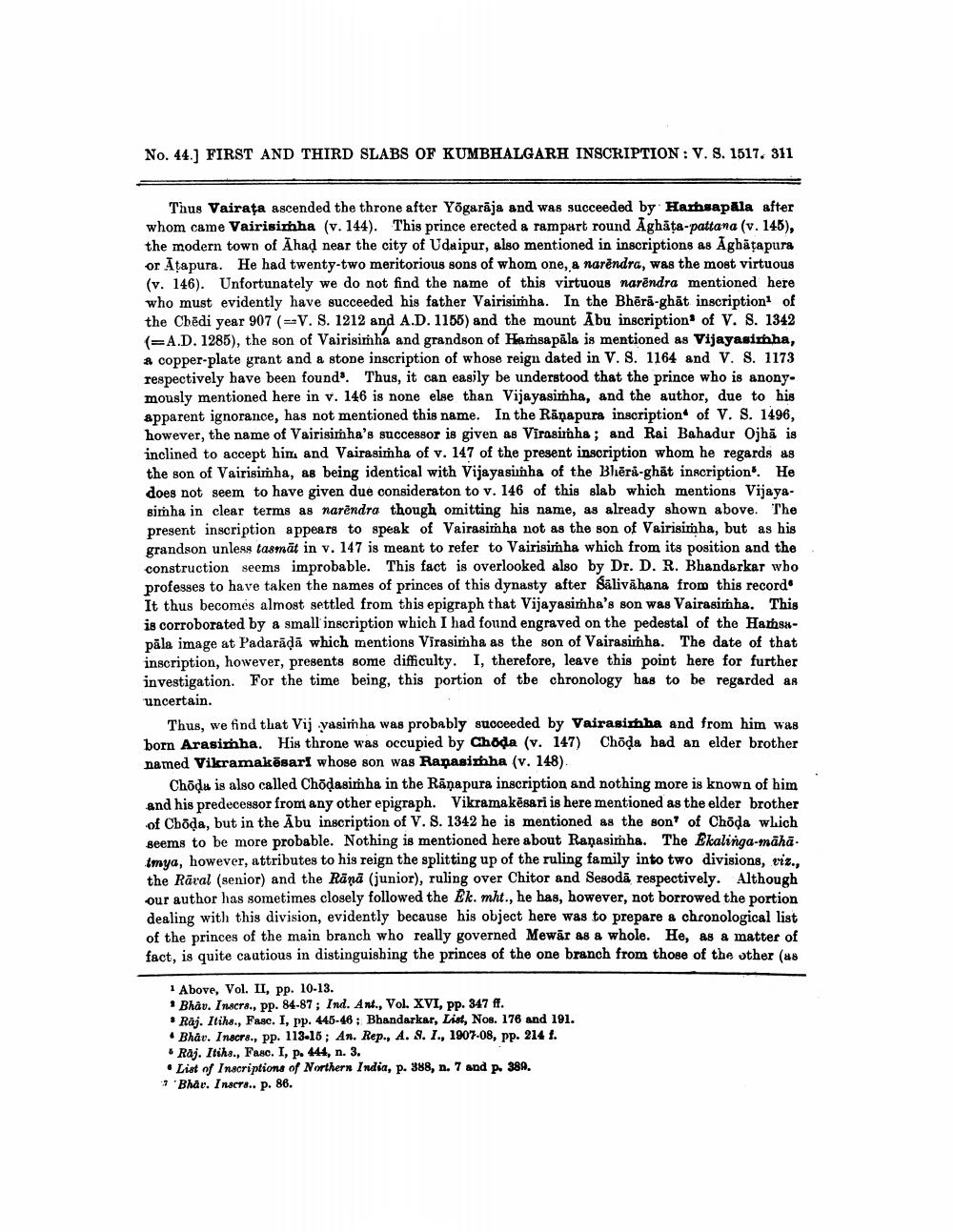________________
No. 44.] FIRST AND THIRD SLABS OF KUMBHALGARH INSCRIPTION: V. S. 1517. 311
Thus Vairata ascended the throne after Yögarāja and was succeeded by Harsapala after whom came Vairisirhha (v. 144). This prince erected & rampart round Aghăța-pattana (v. 145), the modern town of Ahad near the city of Udaipur, also mentioned in inscriptions as Aghățapura or Atapura. He had twenty-two meritorious sons of whom one, a narendra, was the most virtuous (v. 146). Unfortunately we do not find the name of this virtuous narēndra mentioned here who must evidently have succeeded his father Vairisimha. In the Bhēra-ghät inscription of the Chēdi year 907 ( --V. S. 1212 and A.D. 1155) and the mount Abu inscription of V. S. 1342 (=A.D. 1285), the son of Vairisimha and grandson of Hamsa päla is mentioned as Vijayasimha, A copper-plate grant and a stone inscription of whose reign dated in V. S. 1164 and V. 8. 1173 respectively have been found'. Thus, it can easily be understood that the prince who is anony. mously mentioned here in v. 146 is none else than Vijayasimha, and the author, due to his apparent ignorance, has not mentioned this name. In the Ränapura inscription of V. S. 1496, however, the name of Vairisimha's successor is given as Virasiha; and Rai Bahadur Ojhā is inclined to accept hin, and Vairasimha of v. 147 of the present inscription whom he regards as the son of Vairisimha, as being identical with Vijayasinha of the Bhëri-ghät inscription" He does not seem to have given due consideraton to v. 146 of this slab which mentions Vijayasimha in clear terms as narendra though omitting his name, as already shown above. The present inscription appears to speak of Vairasimha not as the son of Vairisimha, but as his grandson unless tasmāt in v. 147 is meant to refer to Vairisimha which from its position and the construction seems improbable. This fact is overlooked also by Dr. D. R. Bhandarkar who professes to have taken the names of princes of this dynasty after Salivähana from this record It thus becomes almost settled from this epigraph that Vijayasimha's son was Vairasimha. This is corroborated by a small inscription which I had found engraved on the pedestal of the Hamsupāla image at Padarādā which mentions Virasimha as the son of Vairasimha. The date of that inscription, however, presents some difficulty. I, therefore, leave this point here for further investigation. For the time being, this portion of the chronology has to be regarded as uncertain.
Thus, we find that Vij yasiṁha was probably succeeded by Vairasimha and from him was born Arasimha. His throne was occupied by Chodla (v. 147) Choda had an elder brother named Vikramakõsarl whose son was Rapasimha (v. 148).
Choda is also called Chodasimha in the Rāņapura inscription and nothing more is known of him and his predecessor from any other epigraph. Vikramakēsari is here mentioned as the elder brother of Cboda, but in the Ābu inscription of V. S. 1342 he is mentioned as the son of Choda which seems to be more probable. Nothing is mentioned here about Ranasimha. The Ekalinga māhā. tmya, however, attributes to his reign the splitting up of the ruling family into two divisions, viz., the Rāral (senior) and the Ränä (junior), ruling over Chitor and Sesodā respectively. Although our author has sometimes closely followed the Ek. mht., he has, however, not borrowed the portion dealing with this division, evidently because his object here was to prepare a chronological list of the princes of the main branch who really governed Mewār 88 & whole. He, as a matter of fact, is quite cautious in distinguishing the princes of the one branch from those of the other (48
1 Above, Vol. II, pp. 10-13. • Bhav. Inacre., pp. 84-87; Ind. Ant., Vol. XVI, pp. 347 ff.
Raj. Iliha., Fasc. I, pp. 445-46 : Bhandarkar, List, Nos. 176 and 191. • Bhav. Inscrs., pp. 113-16; An. Rep., A. 8. 1., 1907.08, pp. 214 . . Raj. Itihs., Fasc. I, p. 444, n. 3. • List of Inscriptions of Northern India, p. 388, n. 7 and p. 38A. :- Bhär. Inscrs.. p. 86.




